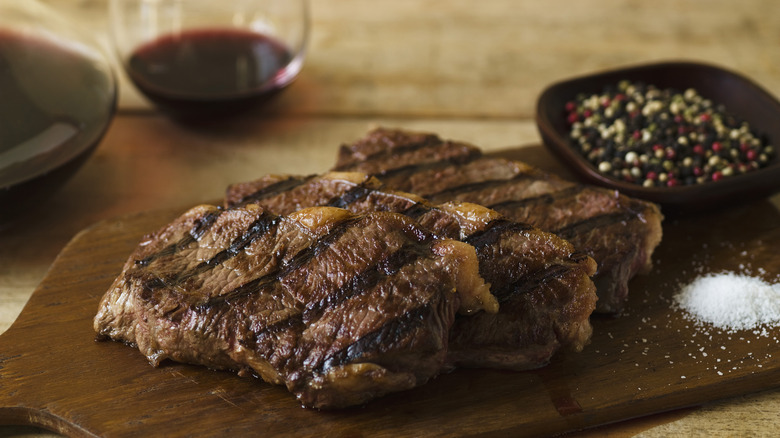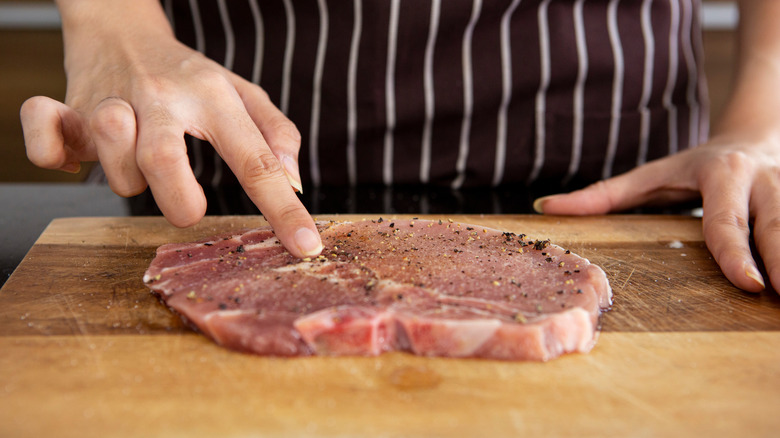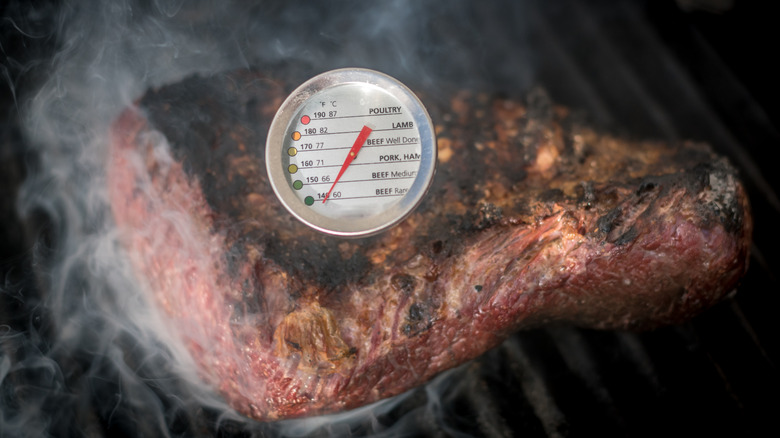How Well Does The Touch Test Work For Determining Meat Doneness?
Whether you're grilling a steak or cooking one on the stove, timing is everything. The difference between rare, medium, and well-done can come down to a matter of minutes, or even seconds, and getting it just within the ideal window for your preferences is a tricky business indeed. You don't want to wait until you're sitting down to eat to cut into your steak and realize you overdid things (or underdid them), which is why the touch test for meat doneness is so appealing. It provides an easy way for you to test how well-done your meat is throughout the cooking process ... at least, that's what it's supposed to do.
If you aren't familiar with the touch test, let's bring you up to speed. To start, touch the fleshy bulge of your hand right below the thumb (this part is called the thenar eminence). It should feel like a raw steak. Then, hold your thumb and index finger together and touch the thenar eminence again. It should feel slightly firmer, and this is the texture you are going for with a rare steak. If you touch your thumb and middle finger together, you have the texture of a medium rare steak. Touch your thumb and ring finger, and you have a medium steak. Lastly, if you touch your thumb and pinky together, your palm should feel like a well-done steak. Many cooks use this textural comparison to determine how well-done their meat is, but research suggests it's not as useful as we've thought.
The touch test is, unfortunately, unreliable
The touch test relies on our subjective perception of textures, which is hardly a reliable gauge for the internal temperature of meat. In a 2015 study conducted in Melbourne, Australia, 26 amateur home cooks tried to determine the doneness of steaks using the touch method. They had just a 36% accuracy rate — far too low to have any confidence in. Granted, the study used a rather small sample size, but it's not the only time that the touch method has been put to the test and come up short.
In 2017, Consumer Reports conducted its own evaluation of the touch test and found that it was inaccurate for every level of doneness. What's particularly worrisome about these results is that the touch test always produced an overestimation, meaning that the steaks being tested came out undercooked. A proper rare steak should have an internal temperature of 125 degrees Fahrenheit, but in the Consumer Reports study, the steak that the touch test determined was rare was actually 106 degrees internally. The steak was undercooked by nearly 20 degrees, and since undercooked meat is more likely to carry foodborne pathogens like salmonella, listeria, and E. coli, relying on the touch test could be really risky.
A thermometer is the best way to test if your meat is done
A meat thermometer is the only way to accurately gauge how well-done your meat is without cutting it open (a step you want to save for the last second so you don't waste delicious meat juice). A thermometer works for any kind of meat and any kind of cut too, unlike the touch test, which is specifically referred to for steaks. To accurately test your meat with a thermometer, simply slide the thermometer in through the side of the cut (this will minimize the cosmetic disruption of having a small hole in your meat) keeping it away from any bones or fat. Then refer to the following temperatures to determine how well-done the meat is.
For rare meat, shoot for a temperature of 125 degrees Fahrenheit. For medium rare, look for 135 degrees; medium is around 145 degrees, medium well is 150 degrees, and finally, a well done piece of meat should register 160 degrees internally. However, it is essential to rest your meat for around 5-10 minutes after you remove it from the heat; otherwise, you will lose a lot of the juice as soon as you cut into it. Meat will continue to cook as it rests, so in order to get the exact level of doneness you desire, you should pull it off the heat when it is five degrees shy of your target temperature. Thus, a medium rare steak should be pulled when the thermometer registers 130 degrees Fahrenheit.


